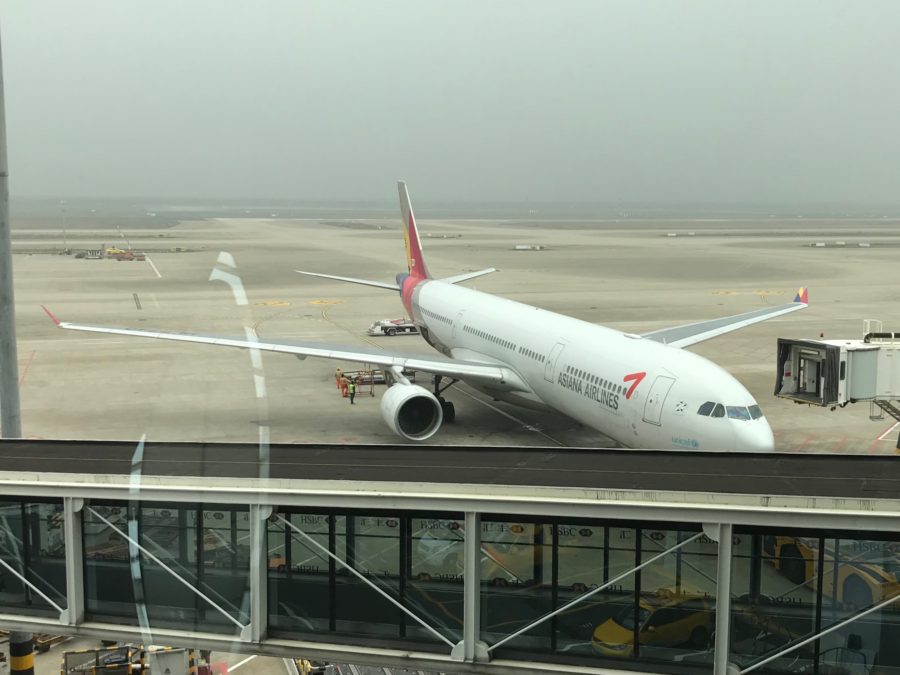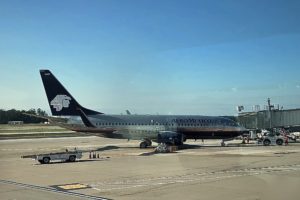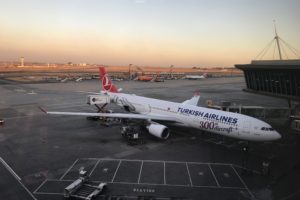Airline Profile: Asiana Airlines
The Facts:
| Alliance | Star Alliance |
| Competitors | Korean Air |
| Fleet Count | About 84 |
| Founded | 1988 |
| Frequent Flyer Program | Asiana Club |
| Headquarters | Seoul |
| Hubs | Seoul Gimpo International Airport Seoul Incheon International Airport |
| Parent Company | Kumho Asiana Group |
| Skytrax Rating | 5 (out of 5) |
| Subsidiaries | Economy Economy Smartium (Extra Legroom Economy) Business (Short-Haul) Business Smartium (Long-Haul) First Club (To be renamed Business Suite) |
| Travel Classes | Economy Business Premier |
| Type of Airline | Full Service |
| Website | flyasiana.com |
Analysis:
7 Things You Need To Know About Asiana Airlines
- Asiana Airlines currently operates to 6 commercial destinations within North America. It flies from its hub at Seoul Incheon Airport to Honolulu on an Airbus A330-300 5x weekly, to Los Angeles 2x daily on both an A380 and on an A350-900, to San Francisco daily on an A350-900, to New York JFK daily on an A380, and to Chicago 5x weekly on a Boeing 777-200, and daily service from Seoul to Seattle on an A350-900.
- Asiana Airlines currently does operate first class and will continue to do so, up until September 1. At that date, first class (only located on the A380) will be rebranded as ‘Business Suite.’ Passengers in business suite will still have access to Asiana’s First Class Lounge and the first class seats, but will be served business class meals and will have business class service. This is a continuation in the movement of airlines moving away from first class and making business class better and better. Malaysia Airlines also recently got rid of first class and rebranded it also as business suite.
- Asiana Airlines also operates a first class cabin on its 747s, although has not sold first class on that aircraft for a few years as it doesn’t operate it on long-haul flights. Similarly to its A380s, it sells it as a designated section of business class, which it labels as “Royal Business.” Asiana Airlines only operates its two 747s sporadically on short-haul routes from Seoul to Hong Kong, Tokyo Narita, Manila, Taiwan, Da Nang, and Ho Chi Min City. At booking, you can upgrade from the angle-flat seats in regular business class to old style but still lie flat first class seats with business class service (Royal Business) for a small fee.

- Asiana Airlines has two airline subsidiaries: Air Busan and Air Seoul. Founded in 2007, Air Busan is a low-cost carrier with one-class service that operates over 25 Airbus A320 series aircraft out of its hub at Gimhae International Airport near Busan. It operates mostly from Busan to destinations in Japan and China, although it also serves Mongolia, Russia, Vietnam, and other nations. Asiana’s second subsidiary, Air Seoul, was founded only in 2015. It operates only 7 aircraft and is a low-cost carrier based out of…Seoul (obviously). It flies primarily from Seoul to many destinations in Japan, although also flies to other nations in Eastern Asia.
- Asiana Airlines operates three lounges at Seoul Incheon Airport. Two of them are Asiana Business Lounges, where access is available to all business class passengers, Asiana Club Diamond members, and Star Alliance Gold (or above) passengers. Additionally, Economy Smartium passengers have access to the lounge on flights from Seoul to North America, Australia, or Europe. The lounges have WiFi, standard airport lounge seating, showers, warm meals, and drinks. It’s First Class lounge is available to first class (after September 1, Business Suite) passengers and Asiana Club Diamond Plus members. The first class lounge features more private seating and better food and drinks than the Business Lounge.

- Asiana Airlines has WiFi available on all of its Airbus A350s, although none of its other aircraft currently have WiFi available. For one hour, WiFi costs about $12, for three hours, it costs almost $17, and for entire flight use, it costs almost $22.
- Seoul Incheon Airport is Asiana Airlines’ main hub. It operates out of the older Terminal 1, and not out of the new Terminal 2, which is dedicated almost primarily to Korean Air. Asiana also has a secondary hub at Seoul Gimpo Airport, in which it operates on a few routes within South Korea and Asia. Out of Gimpo, it also operates the business air route in the world – from Seoul Gimpo to Jeju. On this route, Asiana alone operates up to 28 flights a day, using primarily its Airbus A320, Airbus A321, and Boeing 767-300 aircraft, although there’s also a once-daily flight on an A330-300. The flight is less than 500 miles and is less than one hour long, yet the demand is so big that the majority of its 767s that take up 15 of its daily flights from Seoul Gimpo to Jeju are almost solely dedicated to this route.
Travel Classes
Economy Class
Economy class is featured in a 3-3-3 (rather spacious, considering most other airlines’ 3-4-3 configuration) on all 777s and A350s, a 3-4-3 configuration on all 747s and A380s, a 2-3-2 configuration on all 767s, a 2-4-2 configuration on all A330s, and is in a 3-3 configuration on all A320/A321s. Personal on-demand entertainment is featured on all Airbus A330s, Airbus A350s, Airbus A380s, Boeing 747s, Boeing 777s, and on A321s equipped with business class. Asiana is one of a few airlines that gives its passengers amenity kits – on all long-haul flights, economy class passengers receive a rudimentary amenity kit with eye-masks, ear plugs, (as Asiana puts it) “writing supplies,” slippers, and a toothbrush/toothpaste kit. Power outlets are available on all long-haul aircraft (767s, 777s, A330s, A350s, A380s) and on select Airbus A321s.

In terms of baggage allowance, passenger are allowed to check two 23 kg (50lbs) bags on all US routes (an impressive baggage allowance), but can only check one 23 kg (50lbs) bag on all other routes. Additionally, passengers are allowed to bring one 10kg (22lbs) carry-on bag onboard on all flights. Asiana does offer an extra legroom section of economy class, but only on its Airbus A350-900s, which they label Economy Smartium. In rows 10-14 of their A350s, seats feature 4 inches of additional legroom. Additionally, passengers get access to the Asiana Business Lounge on all long-haul flights while traveling in Economy Smartium. On A350 routes, passengers can select Economy Smartium for an additional fee.
Business Class
Note: Business Class is featured on all widebody aircraft along with being on some Airbus A321 aircraft. Asiana markets its superior business class with lie-flat seats as Business Smartium but markets its inferior business class seats as just Business Class. However, the soft product on both products aren’t any different in both cabin classes but only can vary depending on flight length. On all routes in business class, passengers can check two 23 kg (50lbs) bags and can take two 10kg (22lbs) carry–on bags onboard.
Personal on-demand entertainment is available on all aircraft where business class is featured. Additionally, business class passengers have access to power outlets on all aircraft where the product is available. On the ground, passengers have access to Asiana’s Business Lounge in Seoul, Star Alliance Gold Lounges worldwide, or other partnering lounges. Asiana serves both western meals and Korean meals on most flights. Also, on flights to Australia, the US, to Europe, and to Australia, amenity kits are available, although slippers are available on all flights. Asiana has a large variety of business class seats in its fleet, which are described below (only the best product is marketed as ‘Business Smartium’)
- Recliner: On Airbus A321 aircraft that have business class (A321s with 171 or 174 seats), business class features standard recliner seats in a 2-2 configuration. The seats are pretty similar to domestic first class seats in the United States. However, the seats also do feature personal in-flight entertainment screens, leg rests, and foot rests. The A321s aren’t used on any flights longer than 5 hours (the longest flight is to Phnom Penh), so you won’t be getting a recliner seat on any medium or long-haul flights.
- Angle-Flat: On all of Asiana’s Airbus A330-300s, Boeing 767-300s, and Boeing 747-400s, business class features recliner seats. It is in a 2-1-2 configuration on all 767s, a 2-2-2 configuration on A330s, and a 2-2 configuration on 747s. The seats all have in-flight entertainment screens and power outlets. It’s interesting to note that Asiana actually operates two different types of angled business class seats that are both extremely similar to another – one being older and the other being newer (and happens to be the same seat as on Thai’s 777s and A330s). Asiana operates their angled products on some of their medium-long haul routes, including on their flights to Honolulu (9 hours), Tashkent (7 hours), Jakarta (6.5 hours), and Almaty (6 hours). For the price you pay for business class, on flights that long (especially the Honolulu flight), angle flat seats are simply unacceptable, and should be avoided on their long-haul flights, although they are completely acceptable for a 2-3 hour flight.

- Business Smartium (Stelia Solstys): Asiana’s flatbed business class product is marketed as Business Smartium. It is featured on all of their Boeing 777-200s, Airbus A350-900s, and Airbus A380s. On all three of those aircraft, it is in a staggered 1-2-1 configuration. I happened to fly on the exact same seat model this spring on Hong Kong Airlines. The seats are fine for long-haul flights, have all aisle access, but aren’t all that private, and the quality of the experience depends completely on what seat you choose. If possible, chose a seat that is closer to the window and not a seat that is close to the aisle, because if you choose one of those seats, you will feel completely exposed to the aisle. The seats have a fair amount of storage, and also have personal in-flight entertainment screens and power outlets.

Business Suite
As mentioned earlier in the article, Business Suite is marketed as First Suite until September 1, 2019. When that happens, the first class suites will stay available on the A380s, although the service will be from business class. It will not be a separate cabin class but will be available at an extra charge. However, passengers will still have access to the First Class Lounge in Seoul. Asiana’s Business Suite features closed suites in a 1-2-1 configuration on the bottom deck of the A380. The seats are very standard for first-class products, and similar seats are also featured on many other airlines, such as on SWISS. With a fully closing door (but not up to the ceiling), the seats provide a ton of privacy and space. When First Class is phased out and Business Suites become available on September 1, depending on the price, upgrading to Business Suites can be a good deal as the seats are pretty good even for first class. As it isn’t a separate cabin class, the price difference shouldn’t be that big, and in theory, you could score a first-class seat for (hopefully) little more than business class.

Have you ever flown on Asiana Airlines? Share about your experience below in the comments section!




